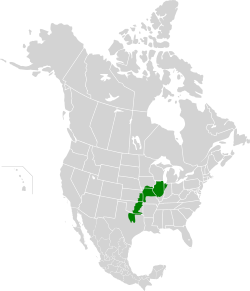Central forest–grasslands transition
| Central forest–grasslands transition | |
|---|---|
 | |
 | |
| Ecology | |
| Realm | Nearctic |
| Biome | Temperate grasslands, savannas, and shrublands |
| Borders | List |
| Bird species | 234[1] |
| Mammal species | 81[1] |
| Geography | |
| Area | 407,000 km2 (157,000 sq mi) |
| Country | United States |
| States | |
| Climate type | Humid continental (Dfa) and humid subtropical (Cfa) |
| Conservation | |
| Habitat loss | 67.6%[1] |
| Protected | 2.09%[1] |
The central forest–grasslands transition is a prairie ecoregion of the central United States, an ecotone between eastern forests and the North American Great Plains. It is a classification defined by the World Wildlife Fund.
Setting
This is a large area covering 407,000 square kilometres (157,000 sq mi) from northern Illinois through most of Missouri, eastern Kansas, Oklahoma and into Texas. This area was traditionally a mixture of woodland and tall grass prairie, which as the soil consists of highly fertile mollisols, most of the area has been converted to farmland. Rainfall varies from 600 to 1040 mm per year and the area is vulnerable to drought and fire. Along with the Upper Midwest forest–savanna transition this ecoregion separates the Central U.S. hardwood forests to the east from the largely treeless Central and Southern mixed grasslands and Central tall grasslands to the west.[2]
Fauna
This ecoregion is rich in reptiles, birds and insects. Birds of the area include the greater prairie chicken. Reptiles include the Osage copperhead snake.
Threats and preservation
The area has almost entirely been converted to agriculture, particularly planting corn and soybeans. Remaining blocks of intact habitat are small and include the Emiquon National Wildlife Refuge an important stopover for migrating birds located across the Illinois River from the town of Havana in western Illinois. Other spots of unspoilt prairie occur in Goose Lake Prairie State Natural Area, Midewin National Tallgrass Prairie and the Kankakee Outwash Plain in Illinois; Indiana Dunes National Lakeshore in northwest Indiana; the Cross Timbers in southern Kansas and central Oklahoma; and the Osage Plains in the south of the ecoregion. However these are all highly fragmented although there are many protected areas in the ecoregion, for example, Prairie State Park in Missouri, and there are also several small tall grass prairie reservations in Cook County, Illinois, including the National Natural Landmark, Gensburg-Markham Prairie.[3]
See also
References
- ^ a b c d Hoekstra, J. M.; Molnar, J. L.; Jennings, M.; Revenga, C.; Spalding, M. D.; Boucher, T. M.; Robertson, J. C.; Heibel, T. J.; Ellison, K. (2010). Molnar, J. L. (ed.). The Atlas of Global Conservation: Changes, Challenges, and Opportunities to Make a Difference. University of California Press. ISBN 978-0-520-26256-0.
- ^ "Central forest-grasslands transition". Terrestrial Ecoregions. World Wildlife Fund.
- ^ [Chicago Wilderness Magazine, Summer 2000 http://www.chicagowildernessmag.org/issues/summer2000/gensburg.html]
External links
- Central forest-grasslands transition, Encyclopedia of Earth
